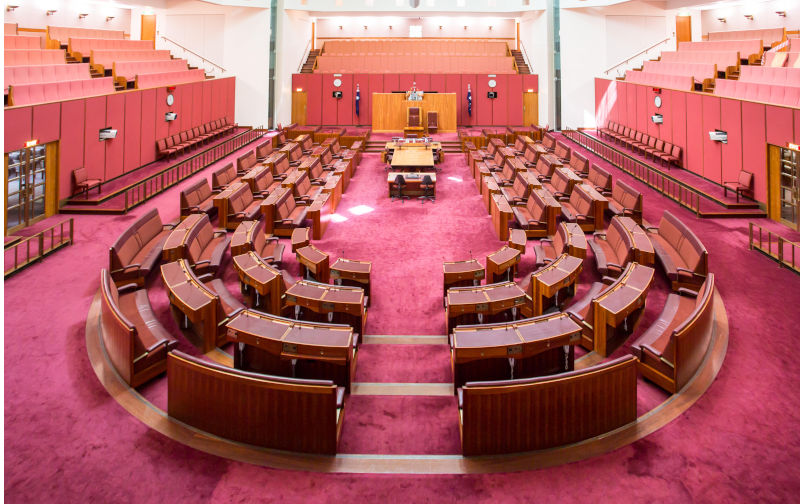Could the Teals win Senate seats in an expanded parliament?
September 30, 2025
Important discussions are taking place within the government and before the Joint Standing Committee on Electoral Matters about increasing the size of the federal parliament.
I support increasing the size of the Senate representation of the states to 14 each, with consequential changes to the size of the House of Representatives.
Such a large increase is caused by the nexus provision in the constitution which requires the House to be twice the size of the state Senate representation.
This remains one of the most counter-productive clauses in the Constitution, but that is an issue for another day.
However, any increased size of state Senate representation will have potential consequences for subsequent elections as it will significantly reduce the quota of votes required to elect a Senator.
It should make it easier for the Greens, One Nation and Jacquie Lambie to maintain their seats, although it will not necessarily enhance their chances of increasing their Senate numbers.
Given the upsurge in House votes for the Teals (that is, candidates supported by Climate 200) in every state, it raises the question of the Senate prospects of similar candidates.
The data shows that if the Teals make the right decisions and commit some resources, it is possible, even likely, that the they could win several Senate seats.
Let’s look at the data from the last election and then at the decisions the Teals and their backers would need to make to bring this about.
In most of the mainland states, the number of first preference votes won by Climate 200-backed candidates suggest that it is an achievable task to gain at least half a quota in an election for a seven-seat Senate election. Once over half a quota, the Teal-backed candidate would be favourite to win a seat.
In NSW, the candidates supported by Climate 200 won 272,872 primary votes in the 11 House seats they contested in 2025. The 6th candidate elected to the Senate in NSW in 2025 was the One Nation candidate who won 302,438 votes or 0.42 quotas. A mere 1000 votes from each of the 35 seats Teal candidates did not contest in 2025 would see a Teal Senate election candidate with at least 307.000 votes or 0.45 quotas. This would put the Teal Senate candidate ahead of One Nation for the 6th position and would certainly suggest a very good chance of winning one of seven available seats in an enlarged parliament.
Nothing can be certain about future elections, but it is clear that there is a possible pathway to success for a Teal Senate candidate in NSW.
The situation in Victoria is a little more complex, but should still be promising for a Teal Senate candidate in the right circumstances.
The 6th candidate elected in Victoria at the last election was a 3rd Labor candidate elected on 2.43 quotas. The eight Teal candidates won 215,006 votes in their House seats which would have been sufficient to gain 0.40 of a quota in the Senate. Approximately 2500 votes per electorate in the remaining 30 seats would have led to 0.5 quotas. The highest vote for an unsuccessful party in the Victorian Senate election in 2025 was 0.31 quotas for One Nation. This would suggest a strong Teal candidate would be the favourite to win a 7th Senate seat in Victoria.
In Queensland, the task would be more difficult, although not impossible, but in WA and SA it might be slightly easier than in the larger states. The votes won by Kate Chaney in Curtin and Climate 200-supported candidates in seats like Forrest would be encouraging for a potential Teal Senate candidate in Western Australia. Although no Teal was elected in South Australia, the vote in Grey, for example, in which the Climate 200 candidate won 18,745 votes suggest a strong candidate would have a good chance in the Senate in South Australia, particularly given the parlous state of the South Australian Liberal party.
Tasmania is harder to judge because of the Lambie factor, but for seven seats in Tasmania the quota would be very small, almost certainly less than 50,000 votes. The performance of Andrew Wilkie in Clark and Peter George in Franklin suggests this should be achievable for a strong Teal candidate.
I also support increased Senate representation for the Territories. Given David Pocock’s success and the continuing failure of the Liberals to appeal to ACT voters, this could create a further opportunity for a Senate success for a Teal candidate.
So, it is obviously possible for a Teal candidate to win one or more Senate seats at the next election. It would be possible, but more difficult, even if the size of the parliament is not increased.
What would they need to do?
The data makes it important that Teal candidates run in more, preferably all, seats. This could be based on only notional campaigns in many seats because very few votes should be necessary in the more difficult seats.
The ACT experience suggests that high-profile candidates would also be a distinct advantage. They don’t all need to be Pocock, but they would need to attract attention in the seats without strong House candidates.
What would not be necessary is a party structure. The current informal processes should be sufficient if the level of support can be maintained.
I am not advocating that Climate 200 and the Teals should take this step.
That is up to them and has risks as well as benefits.
However, the current state of the Liberal Party in every state and the low level of support for the Nationals in most states make it an intriguing possibility.
The views expressed in this article may or may not reflect those of Pearls and Irritations.
